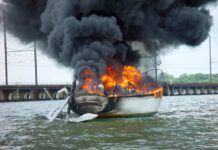When people are hurt and homes and precious possessions are destroyed or lost forever, a wrecked recreational sailboat seems wholly unimportant. But for many people, the boat is their home or is connected to their livelihood.
Sometimes boats that could have been salvaged shortly after a storm were lost due to neglect, but this is expected, given the many other, more critical needs in a storm-ravaged community.
Boat owners should be aware of steps they can take to prevent further loss to their boats. And more importantly, they should be aware of the precautions they can take to keep themselves safe during the period when most storm-related injuries and deaths occur. Already we’re seeing improper use of generators contributing to fatalities after Hurricane Laura.
Here, according to the Boat Owners Association of the United States, are some of the steps you can take to prevent further damage.
- If your boat has washed ashore, remove as much equipment as possible to a safe place to protect it from looters or vandals. Its a good idea to put your contact information somewhere conspicuously on the boat-along with a No Trespassing sign. However, never climb in or on boats that have piled up together or are dangling precariously from dock pilings or other obstructions.
- Protect the boat from further water damage resulting from exposure to the weather. This could include covering it with a tarp or boarding-up broken windows or hatches. As soon as possible, start drying the boat out, either by taking advantage of sunny weather or using electric air handlers. All wet materials such as cushions must be removed and saved for a potential insurance claim. The storm may be gone, but the clock could be ticking on mold growth.
- Any engines and other machinery that has been submerged or has gotten wet should be “pickled” by flushing with fresh water and then filling with diesel fuel or kerosene. To learn how to pickle a boat motor, go to: http://www.BoatUS.com/hurricanes/pickle.asp.
- If your boat is sunk or must be moved by a salvage company, it is not recommended that you sign any salvage or wreck removal contract without first getting approval from your insurance company.
For more tips to help your prepare for and recover from hurricanes, check out the Hurricane Preparedness Guide from Practical Sailor.
Image credit: US Navy file photo









































